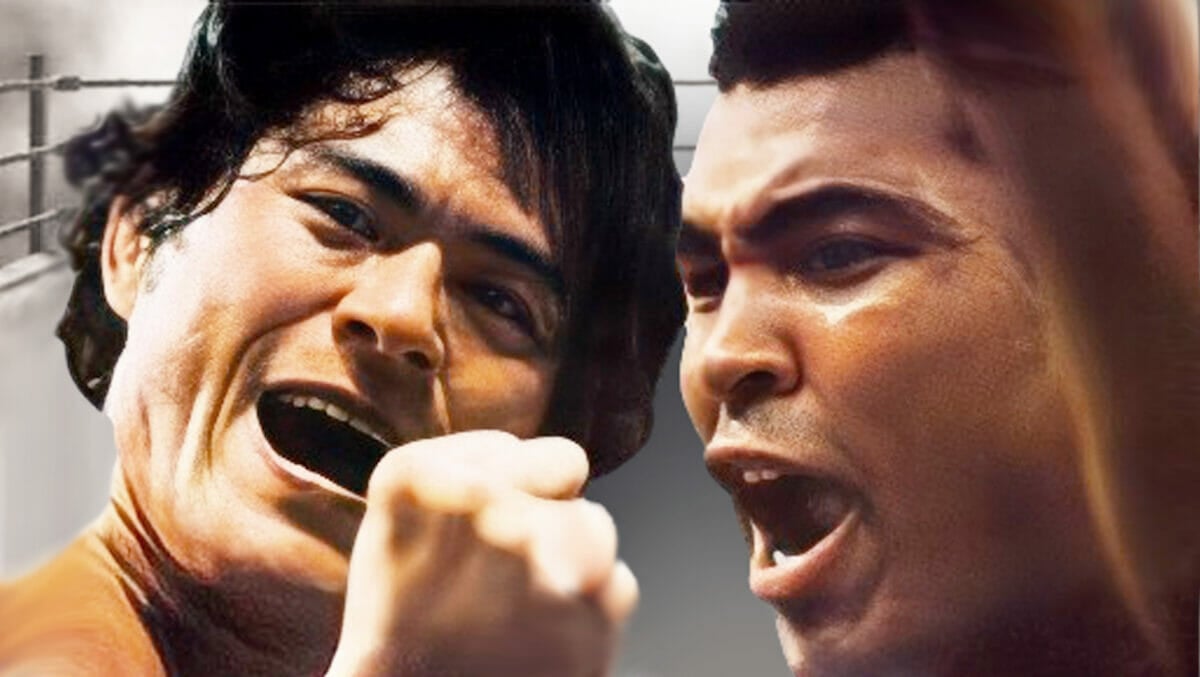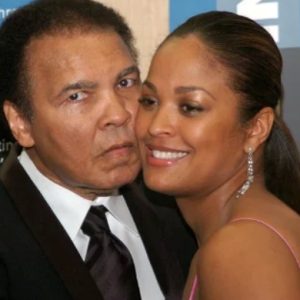The plan was for Muhammad Ali, the greatest boxer in the world, to take a dive.

At least, that’s how wrestling patriarch Vince McMahon Sr. scripted it, according to “Ali vs. Inoki: The Forgotten Fight That Inspired Mixed Martial Arts and Launched Sports Entertainment
While the match became one of the greatest disappointments in boxing and wrestling history, Ali would never go for a fix. Anti-Japanese slurs, however, were tossed around liberally in the run-up to the fight.
In 1976, Muhammad Ali — who died on June 3 at age 74 — was one of the most admired men on the planet. While part of the public consciousness for almost a decade and a half at the time of the Inoki bout, his legend had been sealed eight months prior. The “Thrilla in Manila,” as the fight came to be known, pitted Ali against Joe Frazier in a brutal match on Oct. 1, 1975, that Ali barely won on a technical knockout (TKO) after 14 rounds.
The seed for the mixed-discipline match had been planted in April 1975, when Ali met Japanese wrestling champion and pioneer Ichiro Hatta.
“The story,” writes Gross, “goes that Ali nudged Hatta with a dare: ‘Isn’t there an Oriental fighter who will challenge me? I’ll give him one million dollars if he wins.’ ” The wrestler who accepted Ali’s taunt, Inoki, was one of Japan’s most popular athletes.
Inoki did his best to hype the event. Before the champ got to Japan, Inoki gave the media a tour of the seven-room “imperial” suite where Ali would be staying — and punched his bed.
Ali was more polished in this area. At the press conference announcing the match, he mocked Inoki’s “protruding jaw” and dubbed his opponent “The Pelican.”
Inoki replied, “When your fist hits my chin, I hope you do not hurt your fist.”

It was widely believed in both sports that in a contest between a wrestler and a boxer, the former would have a marked advantage given his wider range of skills and techniques. Ali’s people, including trainer Angelo Dundee and Dr. Ferdie Pacheco, thought his taking the match was “stupid.”
Ali talked about how he’d been warned that the fight could lead to his death or other awful outcomes, saying he’d been told Inoki “could possibly take his fingers and pull my eyes out of my sockets. Or he could take his hands and reach them inside my pants and pull my testicles out.”
“The general consensus,” writes Gross, “was that it was crazy for Ali to step away from boxing to tangle up with a wrestler.” That was almost proven during a promotional exhibition for the match between Ali and US wrestler Gorilla Monsoon, in which Monsoon lifted the boxer up and slammed him to the ground with ease.
Despite the international excitement — the promoters were selling closed-circuit viewing packages — there was much confusion over the bout.
“Fight on the floor like sissy. Man stand up. Man stand up.”
– Muhammad Ali to Antonio Inoki
Given the nature of professional wrestling, so many people assumed the outcome would be predetermined that famous handicapper Jimmy “The Greek” Snyder wouldn’t lay odds on the fight (although others did).
There was also the basic question of what the battle would be, since wrestling and boxing were such different sports. The fighters’ camps had many angry discussions — made worse by Ali’s calling Inoki “that Jap wrestler” in the press — in the days leading up to the fight about who was allowed to do what.
Ali’s camp got Inoki’s to agree to rules that greatly handicapped the wrestler. Inoki’s hands and feet were tied, almost literally, as he was barred from kicking unless he was kneeling, squatting or on the ground.
Inoki was so annoyed that, facing the press with Ali, he proposed making the match winner-take-all for $9 million.
“Including wives?” asked Ali.
“Don’t ask ridiculous questions, please,” responded Inoki.

Both fighters trained seriously. Inoki had people kick him in the face repeatedly to prepare him for Ali’s punches. Ali got himself into prime shape and employed retired wrestler “Classy” Freddie Blassie as trainer.
After the two men met in the center of the ring and shook hands, as per tradition — where Ali told Inoki, “I’m going to send you back to your ancestors” — Inoki ignited the fight just after the opening bell with “a swinging kick toward the champ’s left thigh.”

Inoki then assumed a crab-like martial-arts stance, and this set the tone for the match. Inoki decided on the effective but boring strategy of avoiding Ali’s punches by crouching low and leveling continuous kicks to Ali’s thighs in order to weaken his resolve.
Ali knew he could win the match with one punch, but Inoki gave him no chance to land it. The crowd grew angrier by the round as Inoki slammed Ali’s thighs again and again, causing rainbow-colored bruises, while Ali had no offensive target. While he couldn’t land a punch, though, Ali used his other best weapon — his mouth — effectively.
“You coward. Don’t let the Japanese see you’re a coward,” he said after the first round.
By round two, the crowd was booing, and Ali egged them on. “He’s afraid. He’s a coward. Coward in Tokyo. All your people see you, coward on the floor.” And, soon after, “Inoki cannot wrestle! No wrestle! No wrestle!”
After the fourth round, Ali took to openly questioning his opponent’s manhood. “Inoki girl. On the floor. Fight on floor like girl,” he said, staring directly at Inoki. “Fight on floor like sissy. Man stand up. Man stand up.”
The match did have a few tense moments — Ali landed four punches the entire bout, and Inoki did manage to once send Ali to the canvas — but it basically progressed that way until the end, and consensus held that neither man came close to showing why he was the greatest at his sport.
Making it worse, once the three judges’ scores were added up, the fight was ruled a draw, leaving the angry crowd to scream, “Money back! Money back!”
Ali’s left leg, which absorbed 107 kicks, was so swollen that it “looked like he had dumped a motorcycle and slid along the pavement.” His team was terrified that blood clots might travel from his leg to his heart or brain and begged Ali to stay in bed — Pacheco “made an impassioned plea,” suggesting his legs were “filled with hand grenades” — but Ali had committed to a promotional trip to South Korea and kept his word. Luckily, the swelling went down over time with no additional consequence.
In the end, due to some funky accounting, Ali got only $1.8 million of his promised $6 million. But he was already a rich man and had chosen this fight to, he had hoped, show the world that boxing was a more noble endeavor than wrestling. Then again, some think other factors might have also been at play.
“He’s got the same blood,” said Pacheco of Ali and Inoki. “They had the blood of a con artist. Wrestling is a con. And if they went and wrestled and did crazy things it’s because they were doing stunts. So Ali liked that. He liked the idea of jumping off the top rope and landing on a guy.”
,” a new book by MMA journalist Josh Gross about a long-forgotten Japanese match on June 26, 1976, that pitted Ali, then heavyweight champion of the world, against Japanese professional wrestler Antonio Inoki.
 The idea McMahon hatched for the bout, which came with different rules for each participant based on the specific capabilities and strategies of boxers and wrestlers, was based on “the sneaky Japanese stereotype.” (Welcome to the ’70s.)
The idea McMahon hatched for the bout, which came with different rules for each participant based on the specific capabilities and strategies of boxers and wrestlers, was based on “the sneaky Japanese stereotype.” (Welcome to the ’70s.)
McMahon’s plan called for Ali to slam Inoki with a barrage of punches, and for Inoki to then cut himself with a razor during the match, as wrestlers sometimes do, so he would bleed. Ali would call for the fight to be stopped, Inoki would jump him when his back was turned and pin him, winning the match, and then Ali would angrily invoke Pearl Harbor before returning to America with his seven-figure check.





